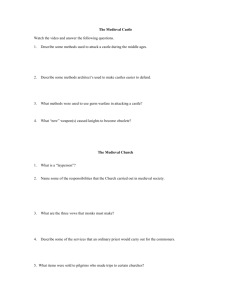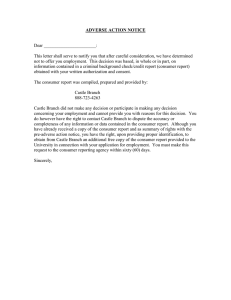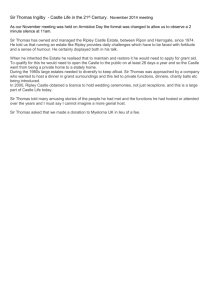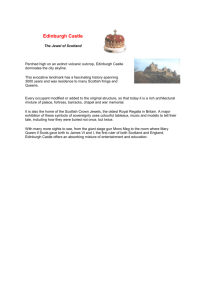A History of the Semple Estate Acknowledgements
advertisement
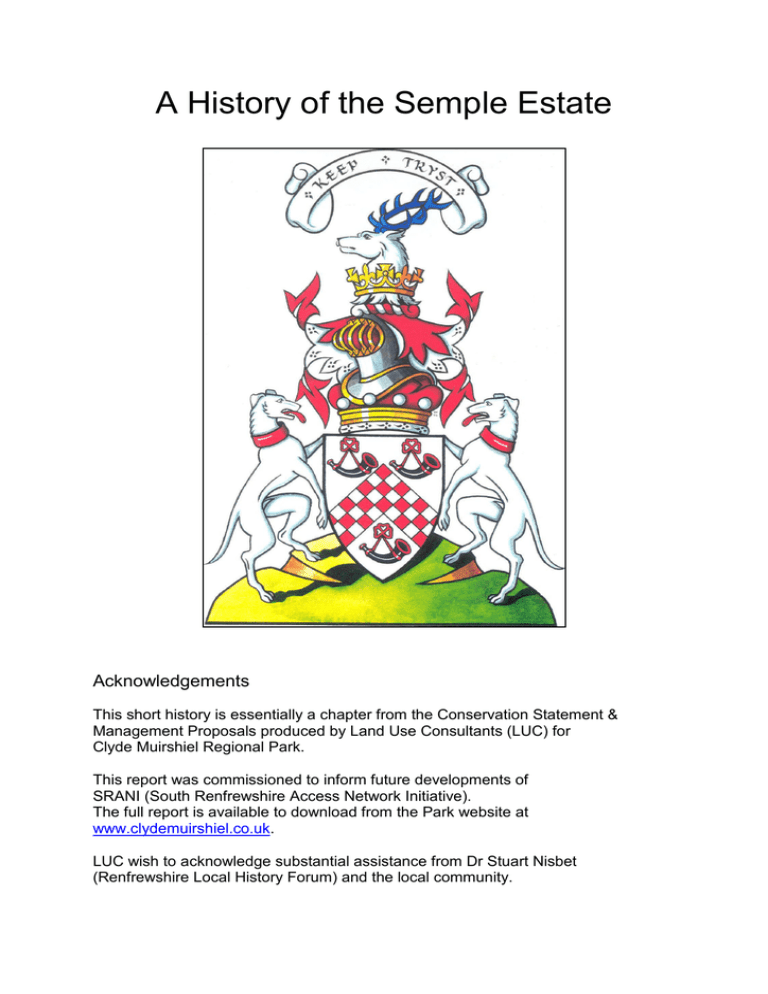
A History of the Semple Estate Acknowledgements This short history is essentially a chapter from the Conservation Statement & Management Proposals produced by Land Use Consultants (LUC) for Clyde Muirshiel Regional Park. This report was commissioned to inform future developments of SRANI (South Renfrewshire Access Network Initiative). The full report is available to download from the Park website at www.clydemuirshiel.co.uk. LUC wish to acknowledge substantial assistance from Dr Stuart Nisbet (Renfrewshire Local History Forum) and the local community. Figure 1: Historic sites and features in relation to the access network THE HISTORY OF THE SEMPLE ESTATE Figure 2: Timothy Pont’s map of around 1580, showing estate, Peel Tower and Elliston Castle (© NLS) Figure 3: Castle Semple Collegiate Church Introduction The Castle Semple Estate is, in many ways, a perfect microcosm of the processes that have shaped the landscapes of lowland Scotland since the medieval period. In addition to bearing the physical evidence of these processes, the high quality documentary record that accompanies the presence of such illustrious families allows episodes of building and landscape design to be tied in to the wider course of events in Scottish and world history. Early History Although the 1791-2 ‘Old’ Statistical Account of Scotland refers to the discovery of ‘canoes’ in Castle Semple Loch during drainage operations, and there are a number of prominent ancient monuments in the vicinity (most notably Walls Hill Iron Age fort, southeast of Howwood), no upstanding prehistoric sites survive on the estate. Given the intensive use of the estate lands for agriculture and the extensive settlement history of the area, it is unsurprising that such ephemeral sites do not survive. The medieval village of Lochwinnoch developed as a ‘Kirktoun’ around the church founded around 1207 as a satellite of Paisley Priory1. Although nothing survives of the medieval structure, it is likely to have been on the same site as the standing gable of the later stone-built church partially demolished in 1808. Later development has obliterated much of the village’s medieval form, which centred along the road now known as Johnshill. Lord John Sempill was granted the charter for the Baronies of Ellistoun (Howwood) and Castleton (the site of the original Castle Semple) by King James III in 1474, beginning the formal connection of the site with the Sempill family which would last for over 250 years. Late Medieval Developments The original Castle Semple, most likely a typical Scottish tower-house, was constructed at the east end of the loch around 1504. The development of castellated architecture was often very fluid and did not conform to a predetermined plan, adding extra rooms and defensive features as funds and local politics dictated. By the time the county was surveyed by Timothy Pont for his map of Scotland2 (around 1580), the castle was a very substantial structure of at least four storeys, set in extensive parkland on the lochside. The collegiate church (see Figure 3) was founded by Lord John Sempill around the same time as the castle was constructed, ensuring the spiritual well-being of the proprietor in this life and the next. The college of canons who staffed the church were employed specifically to pray for the souls of the laird and his family to ease their passage through purgatory. 1 Elevated to Abbey status in 1245 2 Pont 33 ‘Baronee of Renfrew’ – The church was a relatively plain rectangular-plan gothic building, to which a polygonal apse was added around 1514 to house the tomb of Lord Sempill, who – along with around a third of contemporary Scottish nobility and King James IV – died at the battle of Flodden. Warfare played a prominent role in the life of the medieval nobility, but often this took the form of localised – although often brutal – feuding with other landed families, as well as larger scale international conflicts in which they were obliged to participate. The Sempills, as a major medieval family with significant assets, had their share of enemies. In response to the threat from raiding by rival groups, notably the Cuninghames, Robert the third Lord Sempill built a second tower house, known locally as the ‘Peel Tower’3, on an islet in Castle Semple Loch to provide an easily defensible refuge in the event of attack. Tower-houses, although effective at repelling opportunistic raiders, were becoming obsolete as fortification as artillery grew more effective and more readily available. The peel tower itself was besieged and overrun using cannon in 1560. Figure 4: Barr Castle Figure 5: Peel Tower A Peel, or Pele, tower is a slightly different class of monument, with which this site should not be confused. However, ‘peel’ is a commonly used term for fortifications in Scotland, taken from the medieval French word peler meaning palisade. 3 Robert Sempill had been summoned to appear before the Justice General for Scotland to answer charges of murder, burning crops and razing settlements during the course of feuding linked to the dynastic and religious turmoil of the mid-16th century. Rather than give himself up for trial, Sempill fled to the fort of Dunbar, then held by France, leaving his son Robert, Master of Sempill, in charge of the garrison. After preliminary raids by the Earl of Glencairn, the Earl of Arran (Robert Sempill junior’s father-in-law and former Regent of Scotland) constructed causeways out to the peel and, under heavy bombardment, forced the garrison to surrender. Despite being ‘put to the horn’ (outlawed) for a year, Lord Sempill rapidly recovered his position of influence in the Scottish court. The feudal landscape of the Lochwinnoch area survives remarkably well, with fortifications of the 15th and 16th century surviving at Barr Castle, Elliston, Woodside House, Cochrane Tower and Auchenames Tower – all of which are within 3km of the estate boundaries. This gives a strong impression of how densely settled and significant Renfrewshire was during the high middle ages4. Pont’s map of 1580 shows a relatively cluttered landscape, with a number of large estate centres, villages and ecclesiastical sites. Early Modern Period Joan Blaeu’s 1654 Atlas of Scotland shows the Castle Semple estate as a substantial area of parkland enclosed by a paling, with further unenclosed lands to the west. The estate is depicted as being considerably larger than other contemporary landholdings in the area, in common with the depiction on Pont’s map (on which the Atlas was based.) Figure 6: Blaeu's Map, 1654 - based on Pont's surveys (©NLS) 4 Castle Semple Estate lies on the edge of the densest distribution of castles and tower-houses in Scotland. Little remains of the landscape of this period. A network of open fields of rig and furrow cultivation would have surrounded small settlements in rural areas, most of which have vanished through the combined effects of modern agricultural practices and development in and around what would have been small villages. Limited traces of these cultivation remains survive, generally in areas which have fallen out of arable cultivation and have therefore avoided the rigours of modern mechanised ploughing. The aerial photographic record reveals that the remains of these field systems survived relatively intact until at least the early 1950’s5. After this period, the availability of more effective machinery greatly reduced upstanding rig on the estate. The Ordnance Gazetteer (Groome 1882, 251) records that, in 1680, work commenced on partially draining Castle Semple Loch. This marks the beginning of more intensive exploitation of the landscape, and the active modification of the natural environment through the application of technology – albeit relatively basic. The desire to improve the estate and its environment would be a major theme throughout the 18th and 19th centuries. General Roy’s map and mid-18th century estate plans show the gradual superimposition of enclosures on the earlier preImprovement pattern of open ridged fields. The Era of Improvement In 1727 Hugh, the 11th Lord Sempill, sold the Castle Semple estate to William Macdowall, the fortunes of the family having declined during the late 17th and early 18th centuries. Hugh had little time to devote to the estate. His career as a professional soldier kept him away from Castle Semple for most of his life. His illustrious career led him to command two of Scotland’s most famous regiments and fight in the most significant engagements of the day. In 1741 he succeeded Lord Crawford as the commanding officer of the 42nd Regiment of Foot (better known as the Black Watch) while serving on the continent. The regiment were re-designated ‘Lord Sem pill’s Highlanders’ during his command. In 1745 he was appointed colonel of the 25th Regiment of Foot (King’s Own Scottish Borderers). Again, the regiment was renamed in his honour, as ‘Sempill’s Regiment of Foot’ and were recalled to Britain to deal with the emerging Jacobite threat. This culminated in the regiment taking its place on the left flank of the Government army at the battle of Culloden. Sempill assumed command of the government garrison in Aberdeen after Culloden, but was to die a few months later as a result of a botched blood-letting. Although the Macdowalls were originally a landed family from Galloway, Macdowall had made his fortune overseas. As the owner of several sugar plantations in the Caribbean colonies of St Christopher’s (St Kitts) and Nevis6 and through his marriage to Mary Tovey, a sugar heiress, Macdowall amassed considerable wealth, in addition to his military status. 5 Clearly visible on RAF 106G/UK/1027 26 NOV 45 F20, Frames 4235-4239 held by RCAHMS 6 Recently acquired from the Spanish empire Association with the Slave Trade The Caribbean sugar industry, and indeed the majority of transatlantic trade in the 18th and early 19th centuries, was entirely dependent on slaves. In addition to owning several hundred slaves on his plantations, Macdowall actively participated in the transportation and sale of Africans. He is recorded as selling on 68 newly-arrived slaves on St Kitts in 1719 (Graham and Mowat 2003, 32). In 1772, a legal ruling in the Somerset case – where James Somerset, a runaway slave, challenged the right of his former owner to forcibly return him to Jamaica – effectively established that the state of slavery did not exist in English law. This judgement emancipated between 10-14,000 slaves in England and also ruled that slavery contracted in other jurisdictions, including the American colonies, could not be enforced in England. In Scotland, a similar ruling was reached in 1777 when Joseph Knight, having read about the Somerset case, left his master John Wedderburn. The full panel of the Court of Session, including Lord Kames (an important legal and social historian and a prominent figure in the Scottish Enlightenment), reached the decision that the state of chattel slavery (where one person is directly owned by another) did not exist in Scottish Law. Although Knight was freed, he was still legally bound to his master as an indentured apprentice for perpetual servitude. The case for Knight was partly prepared by Samuel Johnson and James Boswell, under the premise that ‘no man is by nature the property of another’ and that, since there was no proof that Knight had voluntary given up his freedom, he should be emancipated. While trading in slaves was outlawed in the British Empire in 1807, and the Royal Navy deployed to prevent it, slaves could still be held in the colonies. In 1827, Britain declared that participation in the slave trade was piracy and therefore punishable by death. Slaves were eventually freed in the colonies by Slavery Abolition Act of 1833, although most remained bound to their masters through an ‘apprenticeship’ system that was not outlawed until 1838. A substantial amount of compensation was paid to plantation owners for their loss, while the former slaves received nothing. To contextualise 18th century slavery, a system of indentured labour existed in Scotland by which workers – particularly miners – were bound to perpetual service in a state of serfdom. These Scottish ‘slaves’ were not freed until 1799. Estate Improvements – William Macdowall I The early 1 8th century was an era of rapid development in science, the arts and social thought. Agriculture, as the principal economic driver of the time, was of particular interest and the development of new machinery, husbandry and land management techniques spread relatively quickly amongst the land-owning classes. Macdowall’s correspondence indicates that, between 1727 and 1730, he contracted William Boucher, a landscape improver, to undertake a range of works on the estate. In common with the fashions of the day, he laid out a formal garden and fishponds. He also undertook the further works to drain the Loch, which is depicted on General Roy’s Map of 1747-55 (see Figure 8). John Watt’s estate plans, dating between 1728 and 1735, show the progress of this work 7 (Nisbet, 2007). Indeed, much of Macdowall’s motivation for purchasing Castle Semple – as opposed to other Renfrewshire estates – was the perceived economic benefit of draining the loch. The 230 year old Castle Semple, despite providing ‘some very good lodgable rooms’ (Hamilton of Wishaw, 1709) was somewhat outmoded and not befitting someone of Macdowall’s social standing. To this end, he contracted Robert Hunter of Ayr to design and build a modern mansion house in the fashionable Palladian style which drew heavily on the design of Macdowall’s Shawfield mansion in Glasgow 8. The original tower-house was demolished to make way, and to provide building materials, for the redesigned estate centre. These features are depicted on an anonymous estate plan dating between 1754 and 1767, which shows gardens in front and to the rear of the new Castle Semple House, which is set in a polygonal area of parkland enclosed by dense tree planting. The estate plan also shows the system of ponds and cascades in the plantation woodlands. Figure 7: Castle Semple House, by Thomas Annan between 1855 & 1887 (©Glasgow City Libraries) Plans in Birmingham City Archives Designed by neoclassical pioneer Colen Campbell for Daniel Campbell, a prominent slave trader, early financier and MP. Shawfield was burnt by an angry mob in 1725, but was purchased and refurbished by William Macdowell in 1726. 7 8 Contrast the appearance of the open fields (depicted by parallel lines) and the enclosures around the Loch Barr Loch appears drained Figure 8: General William Roy's Map of Scotland, 1747-55 (©NLS) From the surviving illustrations of Castle Semple House9, it appears to have been a fine example of a fashionable neo-classical mansion. However, in 1839, it was described as ‘a neat edifice, but not equal to the situation it occupies’ suggesting that the house lacked the presence of designs by more accomplished contemporary architects (Ramsay 1839). However, as probably the richest commoner in Scotland during the mid-18th century, Macdowall is likely to have intended Castle Semple as a country retreat in which he would spend a relatively small proportion of the year. The rights and prestige of becoming a member of the landed classes came with responsibilities with which Macdowall was not immediately aware. The heritors of Lochwinnoch Parish Church immediately began to press Macdowall to provide a bridge across the narrows of Castle Semple Loch, which effectively bisected the parish. In response to his initial intransigence, the heritors took him to court and extracted the costs for the construction of a timber bridge through the Court of Session. Recent research suggests that, on his return to Scotland, Macdowall was shocked to discover that he was unable to control his tenants like he had been able to control his slaves in the Caribbean (Nisbet 2007). William Macdowall II On succeeding his father, the second William Macdowall of Castle Semple pursued a more vigorous programme of improvement, introducing a range of modern agricultural practices including addressing the frequent flooding of the land surrounding the loch and the potential for land reclamation. The Board of Agriculture Survey of Renfrewshire (1812) reveals that, in 1774, Macdowall spent around £3000 (around £290,000 in today’s currency 10 ) on deepening and canalising the Black Cart Water for a distance of around two miles and installing a system of embankments and drains around Barr Loch. This completely drained the Barr Loch and reduced Castle Semple Loch to around a fifth of its original area. By exposing an additional 250 acres of land in the form the Barr, Peel and Aird meadows, the rent revenues of the estate increased considerably. Further developments included the construction of a hothouse in 1776, the improvement of the original deer dyke (on Courtshaw Hill), digging additional ponds and tree planting11. The anonymous late 18 th century estate plan shows a remodelled estate with extensive tree planting in dense woods and open parkland with numerous avenues, rides and carriage drives, and Crawfurd and Semple’s 1782 account of the house records the presence of a bowling green, a hothouse and greenhouses and a grotto – all essential features of the late 1 8th century designed landscape12. 9 Engraving by Ramsay and Lizar, 1839; and photograph by Thomas Annan, between 1855 & 1887 Lawrence H. Officer, "Purchasing Power of British Pounds from 1264 to 2007." MeasuringWorth.com, 2008. Recorded in the 1776 Gardener’s Ledger, held by the National Archives of Scotland GD237/12/49 12 History of the Shire of Renfrew, Paisley, 1782 10 11 William Macdowall III Macdowall’s partnerships with other local landowners and entrepreneurs – notably Alexander Houston – were instrumental in beginning the industrialisation of Renfrewshire. During the 1770’s, their construction of a water-powered limeworks at Corseford began the sequence of development of major water-powered industries in the area (Nisbet 1999). From the late medieval period, the majority of the population of rural Renfrewshire were employed in agriculture, whether as tenant farmers, smallholders or landless cottars. For estate owners and labourers alike, the majority of their income came from farming. However, the process of industrialisation presented hitherto unavailable opportunities for alternative employment, and began to alter the patterns of settlement across lowland Scotland. Planned villages, such as Lochwinnoch, were founded by early industrialists to provide housing for the new factory workforce. The control of water was therefore central to the success of these enterprises and, to this end, the third William Macdowall reversed much of his father’s drainage work to ensure that Castle Semple Loch provided a suitable head of water for the mills on the Black Cart. A weir was constructed on the Black Cart near Elliston to ensure a more consistent level in the loch, and the eastern end was substantially deepened, while the spoil was used to construct picturesque artificial islands in the main vista from Castle Semple House. Macdowall was clearly under considerable pressure to perform these works, as he was the subject of litigation proceeding by disgruntled mill owners in Johnstone and Linwood because of interruptions to their water supply13. During this period, Macdowall was also engaged in continued improvements to the estate, planting numerous trees to enhance the designed landscape and to increase the commercial value of the estate (by 1809 the plantations on the estate were the largest in the county and were valued at £30,000 – around £1.65 million in contemporary currency14). Ainslie’s 1796 map of Renfrewshire shows the estate to be heavily afforested, with ornamental radial plantings around the summit of Parkhill and the ‘temple’ on Kenmure Hill. The drives and rides through the policy woodlands are shown with the sweeping curves made fashionable by contemporary landscape pioneers, such as Lancelot ‘Capability’ Brown. The Calder Mill and two further mills are depicted to the north of Lochwinnoch, along with the Burnfoot Bleachfield. These sites, along with the established nature of the planned village, show the extent to which the area was restructured by the development of the textile industry. Although Macdowall was still investing in the estate, his financial situation was perilous, as Alexander Houston & Co., his main business venture, foundered as a ‘Documents (6) in action of molestation and declarator by feuars on south side of Lochwinnoch [Renfrewshire] against Col. William McDoual [McDowall] of Castlesemple anent his draining and ditching at said loch in alleged contravention of their rights of servitude over it’ National Archives of Scotland GD 124/6/211 14 Figures quoted in the Board of Agriculture Survey of Renfrewshire 1812, converted using equations developed in Lawrence H. Officer, "Purchasing Power of British Pounds from 1264 to 2007." MeasuringWorth.com, 2008. 13 result of the impact of the American and French revolutionary wars on transatlantic trade and the disastrous results of a slave revolt. The effect of this collapse was so severe than an Act of Parliament was passed in 1798 to cushion the blow to Glasgow’s economy. The process of liquidation and settling the company accounts took over seven years, although all accounts appear to have been paid in full but not before all the partners’ assets – including the Castle Semple Estate – had been sold. However, Day Hort Macdowall, William’s youngest brother, undertook to buy back the estate for £100,000 in 1806 (around £6.3 million in current terms15). Although his business interest had remained unaffected by the financial crisis which bankrupted his brother, he appears to have seriously over-estimated his own worth and was unable to meet the 1809 repayment date. Tragically, he took his own life by drowning himself in one of the Castle Semple fishponds. Dissolution, Drainage and Decline This latest financial misfortune to befall the Macdowall dynasty led to the estate being broken up by Day Hort’s heirs in order to hasten the sale and placate the Parliamentary Trustee who had been appointed in 1806 as the receiver for the Houston & Co. Assets. In addition to the financial turmoil caused by the misfortunes of the proprietors (essentially caused by unforeseeable externalities), the estate was subject to pressure from the relentless pace of technological advance in the early 19th century. In 1804, Thomas Telford had been contracted to produce plans for the Glasgow to Ardrossan Canal. The project, first proposed by the 12th Earl of Eglinton in 1791, was designed to connect the industrial centres of Glasgow, Paisley and Johnstone with his newlyconstructed harbour at Ardrossan. Although the scheme was intended to make Ardrossan the principal port for Glasgow and the west of Scotland, funds ran out and the canal terminated in Johnstone. However, John Ainslie’s map of 1812, produced for the Board of Agriculture survey of Renfrewshire, shows the expected route of the canal in the clear expectation that the project would be completed. The Castle Semple portion of the estate was purchased in 1814 by Major John Harvey. James Adam Despite the pressure of modernity, agriculture was still a major source of income in rural Scotland and to this end James Adam, a local solicitor and owner of the Burnfoot Bleachfield on the western edge of Lochwinnoch, purchased the Barr Estate and set about implementing an ambitious drainage project. He had proposed the same scheme to William Macdowall a few years previously although, while the proprietor had accepted the premise, no work had been conducted due to financial constraints. Using the experience he had gained working as the factor on the Drummond Castle estates in Perthshire (particularly relating to his keen observation of the drainage of Blair Drummond Moss) he set about improving the drainage of the Barr Loch. He 15 Officer op cit. improved the engineering of the mid-18th century embankment surrounding the loch, inserting a clay core using pile foundations where necessary. He improved and extended the drainage canals surrounding the loch to intercept and divert the incoming watercourses around the former loch and the Aird Meadows. A substantial canal, running the length of Castle Semple Loch and discharging into the Black Cart, was also constructed to aid the drainage of the Barr Meadows. For the final third of its length, this canal runs in a stone vaulted culvert which, at its deepest, lies around 12 feet below the ground surface. This added considerably to the cost but was necessary as the raised water level in Castle Semple Loch did not provide sufficient fall to allow the Barr Meadows to drain effectively. In addition to the drainage measures, Adam also installed two sluices to allow regulation of the water level in the external canal and, if desired, allow manual flooding of the interior for irrigation (‘warping’) – although no records exist of this taking place. The majority of the labour was provided by Irish navvies, with local labour and a team of ten Lincolnshire men. It is possible, given the extensive drainage works in the Humberhead Levels area of Lincolnshire and the widespread practice of ‘warping’ irrigation in that area, that these men were specialists in drainage operations. The total cost of the construction came to around £7000 – around £373,00016 in contemporary value. Although Adam claimed to make excellent returns from his investment (around 1 3% on an investment of £ 1 0,00017) the spiralling costs of the project took him to the brink of bankruptcy and, in 1819-20, he sold on the Barr estate to yet another William Macdowall. This Macdowall, the nephew of the 3rd William of Castle Semple and the son of the Provost of Glasgow, renamed the much-reduced estate Garthland after the family’s original seat in Galloway. Drainage Disaster In 183 1 the largest of the mill reservoirs in the Muirshiel Heights burst its retaining dam, and resulted in a massive surge down the River Calder. The subsequent impact caused major damage to a number of mills as well as flattening the Barr Loch embankments adjacent to the river, flooding ‘more than 200 acres18’ of reclaimed land. Repairs were affected and, as the Paisley Advertiser recorded in 1838, Barr Meadows produced the ‘most luxuriant crop of oats and hay, which would not have disgraced a more genial clime and southern latitude. 16 Officer op cit. 18 James Adam. ‘The draining of Barr Loch,’ Transactions of the Highland Society, 1829 Paisley Advertiser, 21/11/1831 19 In Clark, S. 1993 ‘Messing about with Water,’ History Scotland Vol. 28, June 1993 17 Figure 1 0: Extract from 1 st edition of the Ordnance Survey 6-inch map (Renfrewshire, sheet XI, surveyed 1857), showing ‘Fog house’ and Ice-house. Fields adjacent to Collegiate Church depicted as formal parkland (shading) Figure 9: Extract from 1st edition OS 6-inch map (ibid) showing estate offices and remodelled walled garden The Harveys In 1814, Day Hort Macdowall’s heirs persuaded the Parliamentary Trustee to accept an offer of £73,000 (around £3.9 million in current value20) from Major John Harvey. His wealth, like that of the Macdowalls, came from the West Indies – although through inheritance rather than direct involvement in transatlantic trade. In common with previous proprietors, Harvey set about making his mark on the estate, contracting prominent garden designer James Hay to remodel and extend the walled garden 21 . However, historical mapping reveals that the Harveys made relatively few changes to the estate as a whole, as it appears more or less unaltered between John Thompson’s Atlas of 183222 and the first edition of the Ordnance Survey Map, published in 186623. It is likely that the impressive Gothic Revival style West Gates and Lodges and Warlock Gates relate to this period, in addition to the now-demolished East Gates. However, it is possible that the icehouse, fancy bridge, grotto and ‘fog house24’ and estate offices were added during this period as these features are not explicitly named on earlier maps (see Figures 8 and 9 on previous page). Harvey’s daughter, Margaret, married Major James Lee in 1816 and, on the death of his father-in-law in 1820, Lee adopted the family name of Harvey. Like his father-in-law, he was a career soldier and served with the Gordon Highlanders in the Napoleonic and Peninsular Wars, retiring from active service in 1814 (on half pay). He was promoted to Lt. Colonel in 1830, prior to his full retirement. Lee Harvey also owned the estate of Mouswald in Dumfriesshire and inherited the family estates in Grenada. He and his family are immortalised in two fine portraits by Sir Henry Raeburn. The first depicts Major Lee Harvey in full military garb with an idealised, romantic landscape in the 20 Figure 11: Sir Henry Raeburn's portrait of Major James Lee Harvey (©Musée du Louvre) Officer op cit Plans in National Archives of Scotland, RHP/5342 National Library of Scotland 23 Renfrewshire, Sheet XI, surveyed 1857, published 1863 24 A small garden summerhouse, built or lined with mossy turf 21 22 background, while the second shows Margaret Lee-Harvey and the couple’s eldest daughter. Raeburn’s inventory – recorded in June 1824, following his death a year earlier – indicates that ‘Major Lee Harvey of Castle Semple’ settled his debt of £315 on the 21st of November 182325. This was a considerable sum for the day, and is equivalent to around £23,000 in contemporary currency. Subsequent generations of the Lee Harvey family are buried in the Collegiate Church. It appears that the Harvey family finances dwindled during the later 19th and early 20th centuries, culminating in the decision to sell the wayleave for the ‘Kilbirnie Loop’ of the Glasgow and South Western Railway through the heart of estate. The line, constructed in 1905, passed less than 100m from the rear of Castle Semple House. The main line along the southern side of Castle Semple Loch had been built in the mid-19th century on the proposed route of the Glasgow and Ardrossan Canal. The proximity of the line to the house is rather evocative, as it highlights the encroachment of the 20th century into the previously impervious country retreat, and essentially heralds the end of the existence of the estate proper. In 1908, the Harvey family sold the estate which was subsequently broken up into a number of smaller holdings and the house converted into apartments. Reshaping the Estate During and immediately after the First World War, the government passed legislation26 to acquire land to establish colonies of smallholdings to resettle some of the thousands of displaced veterans. Under what became known as the ‘Homes for Heroes’ scheme, lowland crofts were established by the Ministry for Agriculture throughout Scotland on land gifted to or purchased by the nation. In 1938, the remainder of the Castle Semple Estate was converted to smallholdings under this legislation and the agricultural land was divided amongst tenant farmers. Although these crofts had varying success in different areas of the country, the Castle Semple examples survive relatively unchanged. By the 1940’s the agricultural value of the Barr Meadows had reduced to the point where it was simply maintained as rough grazing. During the Second World War it was requisitioned by the military for explosives training. RAF aerial photographs, taken during the winter of 194527, clearly show that Barr Loch was still completely dry, although of very poor quality. These photographs28 also Testament of Sir Henry Raeburn, National Archives of Scotland, SC70/1/31 pp. 244-247. Accessed online 03/07/08 http://www.scotlandspeople.gov.uk/content/images/famousscots/fstranscript5.htm 26 Sailors and Soldiers (Gifts for Land Settlement) Act 1916; Smallholding Colonies Act 1916/Land Settlement (Scotland) Act 1919 27 The whole of the UK was surveyed by the RAF between 1945 and 1950 as part of Operation Review – a scheme devised to employ the large numbers of airmen and serviceable reconnaissance aircraft essentially redundant after the end of WWII and to provide the Ordnance Survey with up-to-date aerial photographic coverage of the UK. 28 RAF 106G/UK/1027 26 NOV 45 F20 Frames 4235-4239; RAF 106G/UK/1027 26 NOV 45 F20 Frames 4 1924 198; RAF 106G/UK/ 1027 26 NOV 45 F20 Frames 3190-3196; held by RCAHMS 25 indicate that the smallholdings were well established, but were predominantly pastoral in character (as had been intended) and had not been subjected to intensive ploughing. This is clear from the level of preservation of late medieval rig and furrow field systems which are visible in the aerial photographic record. Having been gutted by fire in 1924, the shell of Castle Semple House was eventually demolished by the Department for Agriculture during the mid to late 1 960’s29. Due to the fact that the area has been subject to the processes of intensive agriculture, little remains of the pre-Improvement landscape on the Castle Semple Estate. However, in areas which have been used as pasture since at least the 18th century – most notably the Kenmure Hill deer park – significantly less ploughing has occurred, preserving the traces of earlier cultivation. An extensive field system, comprising a rectilinear network of field banks and broad, relatively straight, ridges is preserved on the south-eastern flanks of Kenmure Hill. Although broad straight rigs are often associated with the introduction of James Small’s iron ‘swing plough’ during the 1770’s, this area was enclosed as a deer park from at least 1776, which would preclude this interpretation. Similarly, the area is not shown in cultivation at the time of General Roy’s Military Survey of 1747. It can therefore be surmised that the field systems on Kenmure Hill date from the 1 7th century or before, since a later date would generally be accompanied by narrower, more regular ridges. A few other pockets of medieval cultivation survive in the area beyond the Castle Semple estate, adding further detail to the hubs of medieval activity established by Castle Semple, Ellistoun, Barr and other fortifications in the area. The estate landscape laid out during the 1 8th and 1 9th centuries is the most obvious and significant aspect of the historic environment in the Country Park. Policy woodlands, walls, gates and lodges define the extent of the historical estate, while features such as the ornamental waterfalls, grotto and artificial cave tell us much about the quantity of leisure time enjoyed by the 1 8th century gentry. The history of water management has had a particularly strong influence on the landscape, repeatedly changing the shape and form of Castle Semple and Barr Lochs and altering the drainage patterns for a substantial portion of the estate. Influence on Natural Heritage Although Lochwinnoch is renowned for the communities of waterfowl that frequent Castle Semple and Barr Lochs, it is the influence of cultural heritage which has created environments with such high biodiversity value. Were it not for the repeated attempts at draining the lochs, and the creation of the now-flooded meadows, the extensive reed beds and alder carr on the loch margins would not exist in their current form. Similarly, the policies of Castle Semple have provided a significant expanse of woodland which, in other circumstances, is unlikely to have survived. 29 The house is recorded as standing as burnt out ruin in the 1962 Third Statistical Account of Scotland The natural and cultural heritage of the area were recognised as early as the 1940’s, when the Clyde Valley Regional Plan proposed designating the uplands of Renfrewshire as the UK’s first regional park (Abercrombie & Matthew, 1946), finally gaining this status in 1990. The Aird Meadows and Barr Loch were adopted as an RSPB Reserve in 1974 to ensure the long-term protection of the wetland resource.

